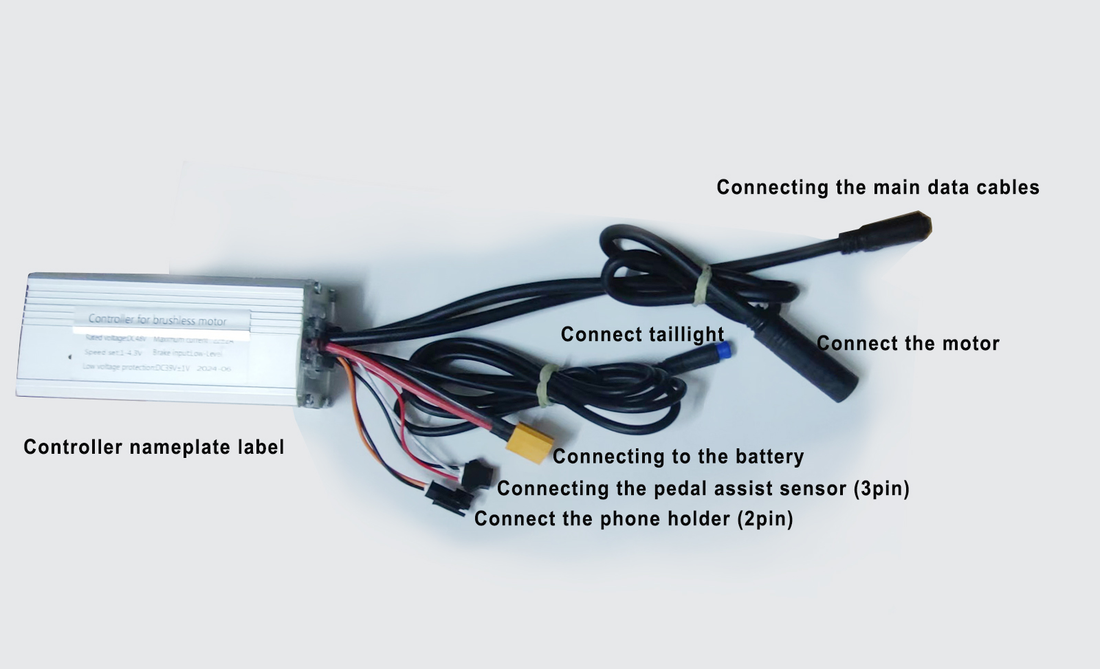
How an Electric Bike Controller Works
Share
1. What is an E-Bike Controller?
The E-Bike Controller is the brain of the E-Bike, regulating the power output of the motor, controlling the speed, managing the battery power, and coordinating the pedal assist system (PAS) or throttle signal. It acts like the engine control unit (ECU) of a car, determining the performance, riding experience, and energy efficiency of the entire vehicle.
2. How an E-Bike Controller Works
The basic principle of an E-Bike Controller is to receive input signals, process data, and send the appropriate current and voltage to the motor. It mainly involves the following steps:
Receive user input:
The rider's input signal is collected through the pedal assist system (PAS) or throttle.
Read the brake sensor to ensure safe power cut-off.
In conjunction with the speed sensor, adjust the riding mode.
Process data and calculate power:
The controller calculates the required power output based on the input signal.
Use PWM (pulse width modulation) technology to accurately adjust the current and voltage to optimize energy efficiency.
Drive motor:
Power is supplied to the brushless DC motor (BLDC) through MOSFET switches to adjust its speed and torque.
Three-phase motors use FOC (field oriented control) or square wave drive to improve efficiency.
Energy management and protection:
Monitor battery voltage to prevent over-discharge or over-charging.
Overheat protection ensures that the controller and motor operate within a safe temperature range.
Current limiting protection prevents instantaneous high current from damaging components.
3. Core components of electric bicycle controllers
Electric bicycle controllers are composed of several key components, which together determine the performance and reliability of the controller.
Microprocessor (MCU): Processes input signals, performs calculations, and controls current output.
MOSFET (field effect transistor): As a switching element, it controls the flow of motor current.
Capacitors and inductors: Used for voltage stabilization and filtering to reduce current fluctuations.
Hall sensor: Detects motor position to ensure accurate commutation and improve efficiency.
Cooling system: High-power controllers require good heat dissipation design to prevent overheating from affecting performance.
4. Types of e-bike controllers
Depending on different needs, the controllers on the market are mainly divided into the following categories:
Square wave controller:
Low price, suitable for basic models.
The driving method is simpler, but the efficiency is low, and it may produce noise and vibration.
Sine wave controller:
Smoother operation, less noise, and improved riding experience.
Higher energy efficiency, but relatively expensive.
FOC (Field Oriented Control) controller:
The most advanced driving method, providing the best energy efficiency and precise control.
Suitable for high-performance e-bikes or high-power models.
5. How to choose a suitable e-bike controller?
When purchasing a controller, you need to consider the following key factors:
Voltage and power matching: Make sure the controller supports your battery voltage (36V, 48V, 52V, 60V, etc.) and motor power (500W, 750W, 1000W, 2000W, etc.).
Controller type: Choose square wave, sine wave or FOC controller, depending on your riding needs.
Support for PAS and throttle: If you want pedal assist + throttle mode, you need to choose a controller that is compatible with both.
Waterproof performance: If you often ride in rainy days, choose a controller with an IP protection rating, such as IP65 or IP67.
Heat dissipation capacity: High-power controllers should be equipped with heat sinks or fans to prevent overheating.
6. Controller Troubleshooting Guide
Common controller failures and solutions:
Controller unresponsive: Check the power connection and battery voltage.
Motor does not rotate: It may be a damaged Hall sensor or MOSFET failure.
Speed is unstable: It may be a PAS sensor or throttle failure, check whether the connection wire is loose.
Overheat protection triggered: Reduce the current setting and improve the heat dissipation environment.
Conclusion: Choose the right e-bike controller for you
The controller is the core component of the e-bike and determines the overall riding experience. Whether you want more efficient energy management, stronger power output, or a smoother riding experience, choosing the right controller can significantly improve the performance of the E-Bike. I hope this article can help you understand how the controller works and find the model that suits you best!
